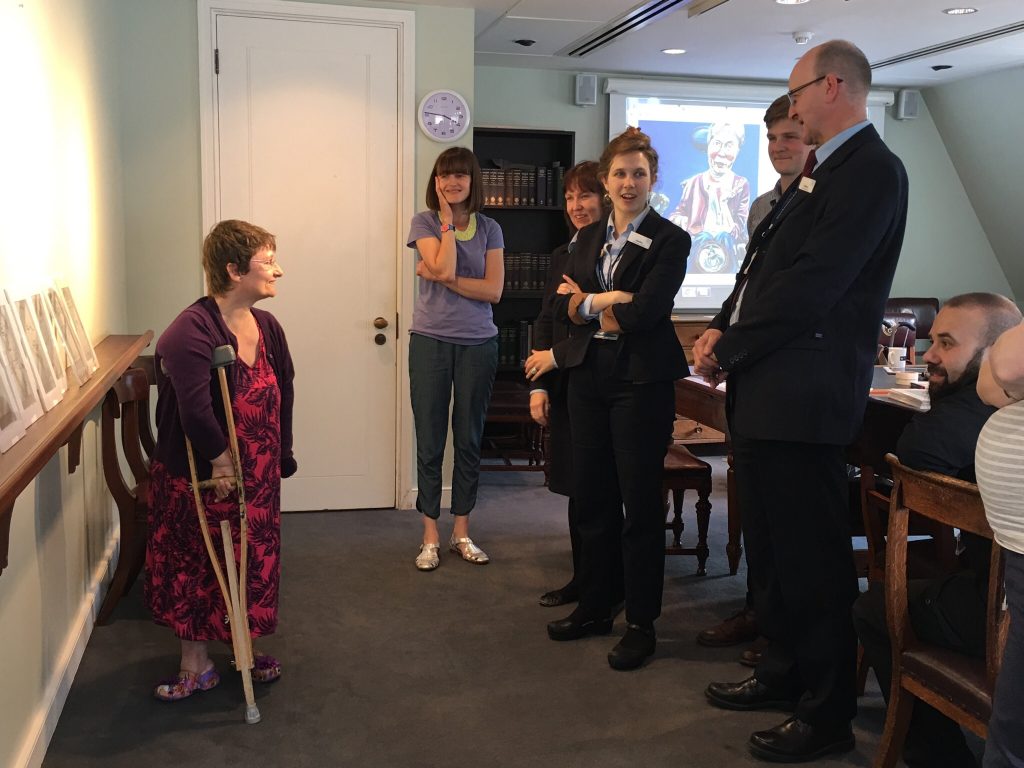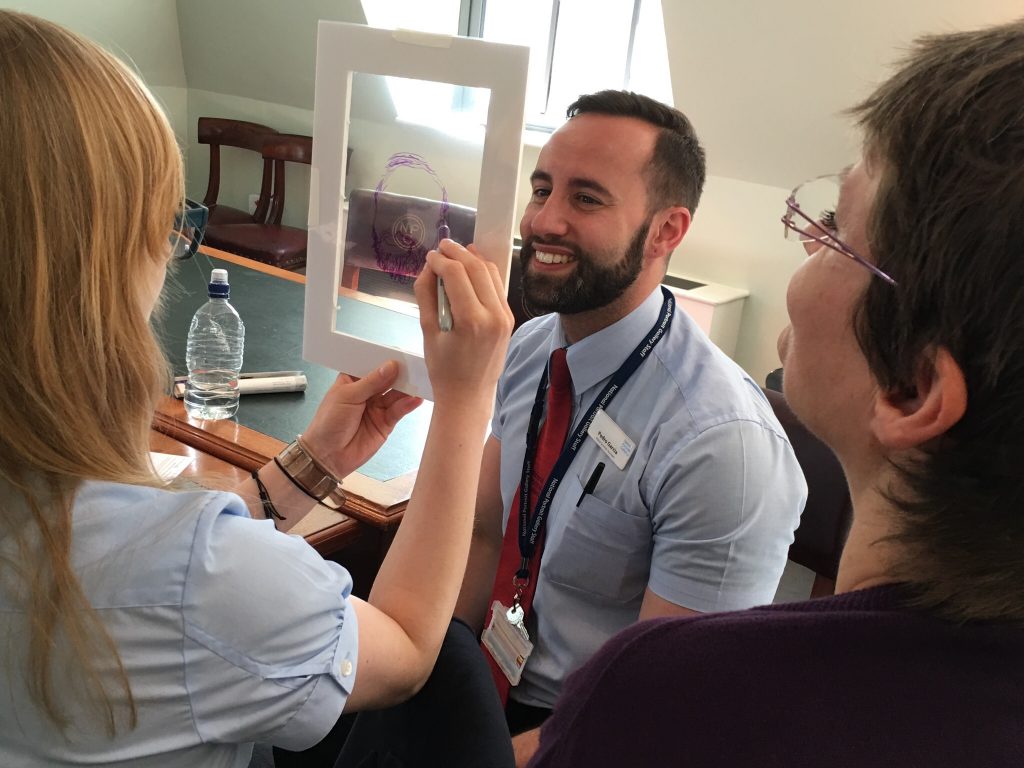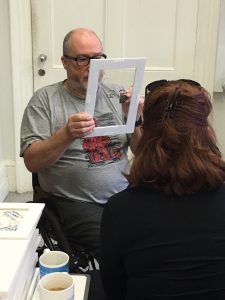
Masterclass and Briefing – National Portrait Gallery
3rd July 2016
Having just run four days of non stop Portrait workshops at the National Portrait Gallery (NPG), I sit in my studio in the Shropshire Hills reflecting and contemplating on how extraordinary my career has been to date.
As an artist and as a self defining disabled artist whose work is born out of the every day experiences of living in a disabling world, I have built my career on portraying myself and other people, exploring identity, disability art and disability/deaf culture.
To be sharing my work and my working practices with the staff and general public within the National Portrait Gallery has been one of my life’s ambitions. I’m feeling very proud.
Last Thursday and Friday I briefed in total 37 members of staff at the National Portrait Gallery. It was a bit like speed dating! Ten members of staff met me in the boardroom at NPG in 30 minute slots. I began by sharing with them a timelapse video of my most recent live portrait sitting that was a commission by Project Ability, Glasgow. I spoke about my portrait sitting process and about the nature of diversity, identities, and our commonality of being human. I introduced Portraits Untold and spoke about the philosophy behind the project and went into more details about the actual sitting of Dame Evelyn Glennie that will take place in NPG on 22 July.

This began to enthuse everyone in the room, but I had one more trick up my sleeve to truly get everyone on board: my acetate portrait exercise. It worked a treat! No matter how many times I do this activity it always feels like the first time and everyone seems to love it. Drawing each other close-up through a window of acetate brings people together and connects them as human beings. Afterwards when I saw the staff at work in the galleries several of them remarked how much they enjoyed the briefing and that they were really looking forward to the event on 22nd July. They have kept their portraits and have stuck them on their lockers – how cool is that! I’m hoping to share this moment on Instagram.

Next was the weekend Portraits Untold masterclass. Again this was a residing success. The first time ever NPG have run an inclusive weekend public workshop! Another Tanya Raabe-Webber pioneering moment. This is something that NPG are committed to developing, which fills my heart with joy as I truly believe that everyone can enjoy drawing and painting given the right access and opportunity.
Over the two-days we explored various portrait making systems. We started with the acetate frames as a warm up giving everyone the opportunity to get to know each other close up and this helped to breakdown any barriers around communication and disabling attitudes. Lots of laughter came from this as we looked at our cartoon like portraits. We then moved to the easels to work out in pairs to do some quick drawing studies capturing the essence of our human form. The drawn portraits were varied in style and approach as I believe is nurturing individual’s natural abilities and not teaching set skills and approaches. Yet still you could recognise each drawing as being of the other person without it being accurately drawn.

This instigated a discussion around portraiture and using formulas and structures to draw faces accurately in a more portrait school kind of way. Even though I can teach structure and formulas I often choose not to use or teach them as I like a more free form approach where mark making and brush strokes develop organically to produce the image of the person. It’s the conversation and the sitter’s physicality that influences and dictates the portrait on a more subconscious level. Because I’ve been creating images of people all my life some parts now come naturally to me though an individual is unique and so this is what drives me to continue to make paintings of people.
We then moved onto a much longer study this time swapping pairs and using paint to draw with. Time for me to do a demonstration! Drawing with paint is always my starting point when starting a painting as I use very little paint on my brush to firstly map out the centre of the face with the eyes then work out from there. I work very quickly establishing the sitter on my canvas within seconds then I continue to develop the portrait using line shape and then form.
We then moved into drawing iPad portraits. This was a new medium for most of the artists and everyone embraced the technology producing some really interesting results. I explained about my interest in fusing traditional painting with digital painting and so we set about projecting one of their drawings on to one of the paintings. This instigated a collaborative demonstration between myself and one of the learning disabled artist from Action Space Studios, London, as we embedded the projected iPad drawing directly into the actual painting by using the drawing to influence our painted structure.
This drew out many discussions around the value and relevance of digital painting vs traditional painting in contemporary painting competitions especially in the NPG BP Prize.
I then joined forces to collaborate with one of the other artists on their iPad digital, traditional painting fusions. One participant travelled from Germany especially for my masterclass as she is interested in developing a portrait that tells a story as she’s writing a book. She painted with real paint whilst I projected my iPhone directly on her canvas and drew digitally using Sketchbook Pro to draw in unison with her directly on to her canvas. We were influencing one another with each other’s mark making. We both felt that it was a unique moment shared.
By the end of the two-day workshop we had created a substantial collection of varied and unique portraits that covered the wall in the studio. A celebration of humanity in portraiture!
Last but not least was the Drawing Room workshop. A drop in workshop for disabled people to access and draw directly from the collections on display in the National Portrait Gallery. Again I got my acetate frames out. This time we used them in front of the paintings to draw what we saw. Many of the participants found that this method provided them with a way of focusing in on the paintings something that they had found difficult previously because of their cognitive impairments. Again we got the iPads out to draw on to which opened up new ways for everyone to use colour and digital paint in the gallery.
This was a really interesting group and I wandered afterwards whether this was the first time this session had been lead by a disabled artist.
I am interesting in exploring the context of diversity, disability culture and a living experience of disability and its representation contemporary portraiture. This leads me on to my next port of call with the National Portrait Gallery, researching diversity and disability in their collections.
You can see more photos from the Master classes on our Facebook page.
For more about Portraits Untold, please visit their website.